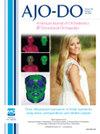Estimation of centers of rotation of the maxillary incisors during nonextraction space closure using the Invisalign appliance
IF 3
2区 医学
Q1 DENTISTRY, ORAL SURGERY & MEDICINE
American Journal of Orthodontics and Dentofacial Orthopedics
Pub Date : 2025-03-25
DOI:10.1016/j.ajodo.2025.02.012
引用次数: 0
Abstract
Introduction
The primary objective was to establish the center of rotation of maxillary incisors during nonextraction space closure with a series of Invisalign aligners (Align Technology, Santa Clara, Calif) and to determine the accuracy of planned orthodontic tooth movement (OTM). The secondary objective was to investigate the efficacy of achieving labiolingual incisor angulation changes planned before the commencement of treatment.
Methods
Digital models representing the pretreatment (T0), planned treatment (T1), and achieved treatment occlusion (T2) were superimposed and analyzed using the Geomagic Control X (version 2022.0; 3D Systems, Rock Hill, NC) software platform. Three-dimensional vector analogs for the long axes of the teeth were generated, and their intersection determined the center of rotation at T1 and T2. The angle formed by the vectors to the y-axis Cartesian plane represented the incisors’ labiolingual angulations at the 3-time points.
Results
A total of 240 maxillary incisors in 60 patients were assessed. The mean (standard deviation) accuracy of achieving the planned OTM for maxillary incisors ranged from 33.2% (31.8) to 35.4% (25.2). Uncontrolled tipping was the most accurate OTM, achieving 76% accuracy for central and 60% for lateral incisors. During the labiolingual incisor change, the planned incisor retroclination was overexpressed by 169% for central and 126% for lateral incisors. Planned incisor proclination was inefficacious, with 10.7% of central and 43.5% of lateral incisors proclining as planned.
Conclusions
Approximately one-third of the planned OTM for maxillary incisors after nonextraction space closure was achieved. Planned maxillary incisor retroclination was overexpressed, and most incisors retroclined during planned proclination.
使用Invisalign矫治器在非拔牙间隙闭合时上颌切牙旋转中心的估计。
简介:主要目的是利用一系列Invisalign矫正器(Align Technology, Santa Clara, Calif .)在非拔牙间隙关闭期间建立上颌门牙的旋转中心,并确定计划的正畸牙齿移动(OTM)的准确性。次要目的是研究在治疗开始前计划的唇舌切牙成角改变的效果。方法:使用Geomagic Control X (version 2022.0;3D Systems, Rock Hill, NC)软件平台。生成牙齿长轴的三维矢量类似物,它们的交点确定T1和T2处的旋转中心。向量与y轴笛卡尔平面的夹角表示切牙在3个时间点的唇舌角。结果:对60例患者共240颗上颌切牙进行了评估。上颌切牙实现计划外切的平均(标准差)准确率为33.2%(31.8)~ 35.4%(25.2)。不受控制的倾斜是最准确的OTM,达到76%的准确率中门牙和60%的侧门牙。在唇舌切牙改变过程中,中切牙计划后倾的过表达率为169%,侧切牙为126%。计划前切无效,10.7%的中切牙和43.5%的侧切牙按计划前切。结论:上颌切牙非拔牙间隙关闭后,约三分之一的计划外切完成。计划性上颌切牙后倾过表达,计划性前倾时大部分切牙后倾。
本文章由计算机程序翻译,如有差异,请以英文原文为准。
求助全文
约1分钟内获得全文
求助全文
来源期刊
CiteScore
4.80
自引率
13.30%
发文量
432
审稿时长
66 days
期刊介绍:
Published for more than 100 years, the American Journal of Orthodontics and Dentofacial Orthopedics remains the leading orthodontic resource. It is the official publication of the American Association of Orthodontists, its constituent societies, the American Board of Orthodontics, and the College of Diplomates of the American Board of Orthodontics. Each month its readers have access to original peer-reviewed articles that examine all phases of orthodontic treatment. Illustrated throughout, the publication includes tables, color photographs, and statistical data. Coverage includes successful diagnostic procedures, imaging techniques, bracket and archwire materials, extraction and impaction concerns, orthognathic surgery, TMJ disorders, removable appliances, and adult therapy.

 求助内容:
求助内容: 应助结果提醒方式:
应助结果提醒方式:


